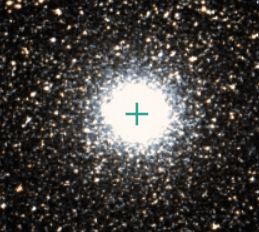DSO of the Month :
Messier 54
AKA: NGC 6715
Position: 18 hr 55 min 03 sec -30 degrees 28 min 43 sec
Due south at 22.20 (BST) on 15 July 2022
Messier 54
Image: Simbad (http://simbad.u-strasbg.fr/simbad/).
The globular cluster Messier 54 in the southern part of Sagittarius may seem an unpromising Object of the Month. At a declination of 30 degrees south it is on the limit of what can be seen from Havering and it is noteworthy that it has never been imaged by one of our members. At magnitude 7.6, it is pretty dim and it is made even dimmer by its low position in the sky, being extincted to magnitude 9 at best. Furthermore its stars cannot be resolved even in a large amateur telescope. A brighter and higher globular cluster n Sagittarius such as Messier 22 would seem to be a more obvious target. I have included in this series because it is interesting rather than being easy to see. It was assumed that M54 was in the Milky Way galaxy but in 1994 it was shown that it probably belongs to the Sagittarius Dwarf Elliptical Galaxy and is hence extragalactic. The Sagittarius Dwarf Elliptical Galaxy was discovered in 1994 and is probably the nearest galaxy to the Milky Way, but lies on the opposite side of the Milky Way to us. It is even possible that M54 is the core of the Sagittarius Dwarf Elliptical Galaxy and in 2009 astronomers found evidence that it might contain an intermediate-mass black hole which have been elusive. Its great distance of 87,000 light years explains why such a bright large globular cluster is so dim in our sky. It is intrinsically brighter (absolute magnitude of -10 vs -8.5) and much larger (radius of 153 light years vs 84 ly) than Messier 13 which is only a quarter of that distance from us, but remarkably M54 is much closer than the Intergalactic Tramp (see DSO of the Month for February 2021). M54 was first observed by Charles Messier in 1778 but he had no idea that it was a globular nebula. M54 is relatively easy to find in a reasonably large telescope as it is close to Zeta Sagittarii (Ascella) which is magnitude 2.6 a little bit along the line towards Epsilon Sagittarii (mag. 1.9) which is the bottom of the teapot asterism. Ascella is where the handle of the teapot joins the bottom of the body of the pot. The major problem is that even when it is due south M54 does not rise more than 8 degrees above the horizon in Havering. Either get a clear horizon to the south or observe it during a holiday to more southern latitudes – it would be an easy observation in southern Portugal or Mexico.
ARCHIVE
